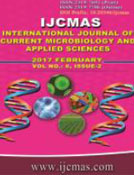


 National Academy of Agricultural Sciences (NAAS)
National Academy of Agricultural Sciences (NAAS)

|
PRINT ISSN : 2319-7692
Online ISSN : 2319-7706 Issues : 12 per year Publisher : Excellent Publishers Email : editorijcmas@gmail.com / submit@ijcmas.com Editor-in-chief: Dr.M.Prakash Index Copernicus ICV 2018: 95.39 NAAS RATING 2020: 5.38 |
Cellulose constitutes bulk of the plant cell wall materials and the most abundant and renewable non-fossil carbon source on earth. Cellulose degrading fungi play an important role in recycling of cellulosic materials. Thus, this study was designed to screen endophytic fungi isolated from Cameroonian medicinal plants for their cellulase activity. The plate-clearing assay and enzyme assay methods were used for screening of potent cellulolytic endophytic fungi. The promising was chosen for filter paper cellulase (FPCase) and carboxymethyl cellulase (CMCase) assay. The most potent was Penicillium sp 51 (50mm), followed by P. chermesimum (30-37.5mm) and Penicillium sp (22.5-30mm). The total cellulase activity (FPase) was 0.36 U/mg and 0.44U/mg for avicel and CMC crude enzymes respectively. The optimal pH and temperature for activity of crude cellulases produced by Penicillium sp 51 were respectively from 5-6 and 40-50°C. This endophytic fungus can be used for industrial bioconversion of cellulose.
 |
 |
 |
 |
 |